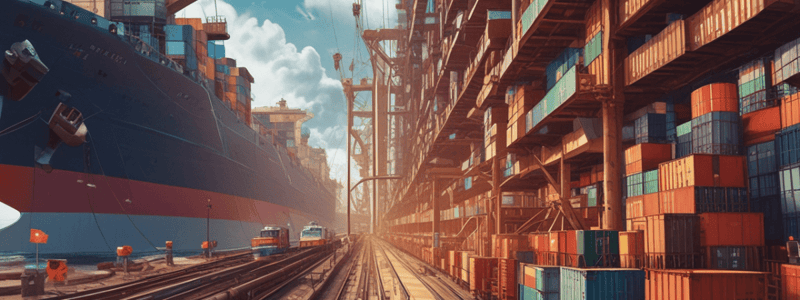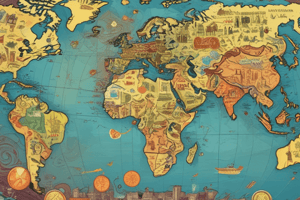Podcast
Questions and Answers
According to mercantilism, a country's wealth is measured by its GDP.
According to mercantilism, a country's wealth is measured by its GDP.
False (B)
The theory of absolute advantage was introduced by Adam Smith in 1500.
The theory of absolute advantage was introduced by Adam Smith in 1500.
False (B)
Free trade theories endorse a laissez-faire approach of no governmental intervention.
Free trade theories endorse a laissez-faire approach of no governmental intervention.
True (A)
Neomercantilism aims to achieve a trade deficit.
Neomercantilism aims to achieve a trade deficit.
Mercantilism was the foundation of economic thought for nearly two hundred years.
Mercantilism was the foundation of economic thought for nearly two hundred years.
Adam Smith's theory of absolute advantage holds that a country can maximize its own economic well-being by specializing in the production of those goods and services that it can produce at a higher cost than any other nation.
Adam Smith's theory of absolute advantage holds that a country can maximize its own economic well-being by specializing in the production of those goods and services that it can produce at a higher cost than any other nation.
Trade theory helps managers and government policymakers focus on four critical questions.
Trade theory helps managers and government policymakers focus on four critical questions.
Interventionist trade theories endorse a laissez-faire approach of no governmental intervention.
Interventionist trade theories endorse a laissez-faire approach of no governmental intervention.
According to Smith, workers become more skilled by repeating the same tasks and switching from the production of one kind of product to another.
According to Smith, workers become more skilled by repeating the same tasks and switching from the production of one kind of product to another.
A country's natural advantage is solely due to its access to particular resources.
A country's natural advantage is solely due to its access to particular resources.
An acquired advantage is a result of natural advantages among countries.
An acquired advantage is a result of natural advantages among countries.
The production possibilities curve shows that specialization and trade will always lead to a decrease in global efficiency.
The production possibilities curve shows that specialization and trade will always lead to a decrease in global efficiency.
Ricardo's theory of comparative advantage holds that a country can maximize its own economic well-being by producing everything it needs.
Ricardo's theory of comparative advantage holds that a country can maximize its own economic well-being by producing everything it needs.
Smith asserted that country-specific advantages can only be natural.
Smith asserted that country-specific advantages can only be natural.
Technology has created new products, displaced old products, and altered trading-partner relationships, but it has not affected global efficiency.
Technology has created new products, displaced old products, and altered trading-partner relationships, but it has not affected global efficiency.
Real income depends on the resources used to produce a product, regardless of the output.
Real income depends on the resources used to produce a product, regardless of the output.
China has a large economy because of its small population.
China has a large economy because of its small population.
The top ten nations account for less than one-quarter of all of the world’s trade.
The top ten nations account for less than one-quarter of all of the world’s trade.
The factor-proportions theory assumes production factors to be heterogeneous.
The factor-proportions theory assumes production factors to be heterogeneous.
Most new products originate in developing countries.
Most new products originate in developing countries.
High-income countries trade primarily with emerging economies.
High-income countries trade primarily with emerging economies.
The country-similarity theory suggests that companies create new products in response to market conditions in foreign markets.
The country-similarity theory suggests that companies create new products in response to market conditions in foreign markets.
Emerging economies primarily export capital-intensive products.
Emerging economies primarily export capital-intensive products.
Distance has no effect on the determination of trading partners.
Distance has no effect on the determination of trading partners.
Factor mobility via foreign direct investment may reduce foreign trade.
Factor mobility via foreign direct investment may reduce foreign trade.
LUKOIL's foreign investments are limited to nearby countries.
LUKOIL's foreign investments are limited to nearby countries.
LUKOIL's foreign acquisitions are primarily aimed at gaining access to new markets.
LUKOIL's foreign acquisitions are primarily aimed at gaining access to new markets.
The inability to gain sufficient access to foreign production factors may hinder domestic substitution.
The inability to gain sufficient access to foreign production factors may hinder domestic substitution.
LUKOIL controls 10 percent of Russia's oil production and refining capacity.
LUKOIL controls 10 percent of Russia's oil production and refining capacity.
Short-term capital is less mobile than long-term capital.
Short-term capital is less mobile than long-term capital.
High market prices have enabled LUKOIL to reduce its foreign investments.
High market prices have enabled LUKOIL to reduce its foreign investments.
The Diamond of National Advantage Theory suggests that the existence of favorable conditions is sufficient for the development of a particular national industry.
The Diamond of National Advantage Theory suggests that the existence of favorable conditions is sufficient for the development of a particular national industry.
LUKOIL's forward integration into filling stations is aimed at reducing its market access.
LUKOIL's forward integration into filling stations is aimed at reducing its market access.
The Costa Rican government did not alter its educational system to fit the needs of targeted industries.
The Costa Rican government did not alter its educational system to fit the needs of targeted industries.
Global political and economic conditions do not affect global oil markets and prices.
Global political and economic conditions do not affect global oil markets and prices.
Factor mobility theory focuses on why production factors remain static.
Factor mobility theory focuses on why production factors remain static.
People are less mobile than capital.
People are less mobile than capital.
Firms can only gain market information and production inputs from domestic sources.
Firms can only gain market information and production inputs from domestic sources.
The Diamond of National Advantage Theory is only applicable to domestic conditions.
The Diamond of National Advantage Theory is only applicable to domestic conditions.
The creation and persistence of national competitive advantage requires outdated product and process technologies.
The creation and persistence of national competitive advantage requires outdated product and process technologies.
Study Notes
Trade Theory and Factor Mobility
- Trade theory helps managers and policymakers answer critical questions: what products to import/export, how much to trade, and with whom to trade.
Interventionist and Free Trade Theories
- Interventionist trade theories (mercantilism and neomercantilism) endorse governmental intervention in trade movements.
- Free trade theories endorse laissez-faire approach of no governmental intervention.
Mercantilism
- Focuses on amassing a surplus (favorable balance of trade) by exporting more than importing, collecting gold and other forms of wealth from countries with a deficit (unfavorable balance of trade).
- Governments impose restrictions on imports and subsidize products for export.
Neomercantilism
- Seeks to achieve social or political objectives by running a favorable balance of trade (export surplus).
Free Trade Theories
Theory of Absolute Advantage (Adam Smith, 1776)
- A country maximizes its economic well-being by specializing in the production of goods and services it can produce more efficiently than any other nation.
- Specialization enhances global efficiency through unrestricted free trade.
- Workers become more skilled by repeating tasks, don't lose time switching between products, and long production runs provide incentives for effective working methods.
- Country-specific advantages can be natural or acquired.
Natural Advantage
- Climate, access to resources, labor availability, etc. create natural advantages for producing certain products.
Acquired Advantage
- Represents a distinct advantage in product or process technology, yielding differentiated products and/or cost-competitive homogeneous products.
- Technology creates new products, displaces old ones, and alters trading relationships.
Resource Efficiency
- Real income depends on output compared to resources used to produce products.
- Specialization and trade optimize global efficiency.
Theory of Comparative Advantage (David Ricardo, 1817)
- A country maximizes its economic well-being by specializing in the production of goods and services it can produce relatively efficiently.
- Even if other countries can produce the same goods more efficiently, there are still gains from trade.
Factor-Proportions Theory (Eli Heckscher and Bertil Ohlin)
- Countries trade based on their relatively abundant production factors.
- Theory assumes production factors are homogeneous, but tests have been mixed.
Country-Similarity Theory
- Companies create new products in response to market conditions in their home market and then export to similar markets.
The Diamond of National Advantage Theory (Michael Porter)
- The creation and persistence of national competitive advantage require leading-edge product and process technologies and business strategies.
Factor Mobility Theory
- Focuses on why production factors move, the effects of that movement on transforming factor endowments, and the impact on international trade.
- Capital, technology, and people move due to differences in expected returns and government incentives.
Capital Mobility
- Short-term capital is the most mobile of all, transferred due to differences in expected returns, firm responses to government incentives.
People Mobility
- People move to access foreign production factors, stimulating efficient domestic substitution methods.
Complementarity
- Factor mobility via foreign direct investment stimulates foreign trade due to the need for components, complementary products, and equipment for subsidiaries.
Studying That Suits You
Use AI to generate personalized quizzes and flashcards to suit your learning preferences.
Related Documents
Description
This quiz covers the basics of trade theory, including interventionist and free trade theories, and helps managers and policymakers answer critical questions about international trade.




